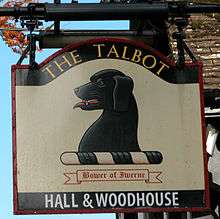Talbot (dog)
| Origin | Uncertain, possibly Belgium / France (Normandy) or England |
|---|---|
| Breed status | Extinct |
| Domestic dog (Canis lupus familiaris) | |
The Talbot was a type of white hunting dog. It is now extinct because of its lack of purpose and need for constant care, but it has been credited with being an ancestor of the modern beagle[1] and bloodhound.[2] The term talbot is used in heraldry to refer to a good-mannered hunting dog.
History

The breed has been said to have originated in Normandy, perhaps to have been the white St Hubert Hound, and to have been brought to England by William the Conqueror, but this is not supported by evidence. There are no known references to the talbot as a breed of hound in Medieval French, and none have been found in English before the mid-16th century.
In Medieval times, "Talbot" was a common name for an individual hound, so used before 1400 in Chaucer's The Nun's Priest's Tale (l 3383), and used as an example of a hound name in a 16th-century book of hunting.[3]
By the 17th century it clearly existed as a breed or type. Large, heavy, slow hounds were 'talbot-like', whatever their colour, though the 'milk white' was 'the true talbot'.[4] William Somervile in his poem "The Chase",[5] published 1735, describes the former use of "lime-hounds" (leashed hounds) on the Scottish Borders to catch thieves, obviously referring to the bloodhound and the sleuth hound, but adding that the (white) talbot was the "prime" example of this type of hound.
The origin of both the name and the animal is uncertain. The Earls of Shrewsbury, whose family name is Talbot, have as their family crest a white, short-legged hound. In a quotation from about 1449, the king referred to John Talbot, 1st Earl of Shrewsbury as "Talbott, oure good dogge", perhaps as a play on his name, or in allusion to the family badge.[6] In a MS in the British Library [7] John Talbot is shown presenting a Book of Romances to Queen Margaret, with a white dog standing behind him, which serves, symbolically, to identify him. It is obviously a small hound, and it seems unlikely that it could have been used in this way if "Talbot" had been associated in the mind of the people of the time with a large animal.
The talbot and the greyhound were, apparently, the only hounds used in English heraldry, and it could be that the talbot originated as an emblematic or heraldic hound.[8] References to this heraldic talbot seem to be earlier than any references to a real dog.[9] The talbot figures in many Coats of Arms, for instance in later ones of the earls of Shrewsbury, in which two talbots appear as supporters.[10]
It is quite a plausible idea that from these beginnings the name "talbot" was extended to any large heavy white scent hound, and from there helped to establish a breed or type. It was certainly similar to the bloodhound (and "white" is given as one of the colours of the bloodhound around the 16th and 17th centuries)[11] as regards size, and use as a leash-hound.[4]
As earliest references to this dog are much later than those to bloodhounds it cannot convincingly be regarded as an ancestor of the bloodhound.

The talbot seems to have existed as a breed, a little distinct from the bloodhound, until the end of the 18th century,[12] after which, like two other large breeds to which it may have been related, the Northern and the Southern Hound, it disappeared. Some early dog-shows apparently offered classes for talbots, but they were never entered, and so were dropped.
Cultural legacy
"The Talbot" (or "Talbot Arms") is most familiar as the name of some English inns or public houses, and it is usually depicted on the signs as a large white hound with hanging ears, sometimes with spots. This suggests that the talbot was quite well known at one time, as part of the idea of a sign was that it helped to identify the inn for the illiterate. An inn called The Talbot in Iwerne Minster, Dorset, UK, showed as its sign a black dog, apparently the crest of the Bower family, who owned the manor from the late Middle Ages till 1876.[13]
The market town of Sudbury, Suffolk, in the east of the United Kingdom has a talbot on its town crest, which is also used for a local school and many local sports clubs. The dog is always depicted with its tongue protruding.
The arms of the Carter of Castle Martin family (see Carter-Campbell of Possil) include a talbot. The arms of the Earls Waldegrave is supported by two talbots.
References
- ↑ "The Beagle". Buzzle.com. Retrieved 2014-05-13.
- ↑ "Mac Barwick's History: Chapter VI". Bloodhounds.org.uk. Retrieved 2014-05-13.
- ↑ "Turberville, George (1575) ''The Noble Art of Venerie or Huntyng''". Archive.org. Retrieved 2014-05-13.
- 1 2 Markham, Gervaise (1605). Country Contentments or the Husbandman's Recreations.
- ↑ Somerville, William (1735). The Chase Book 1 Ll282-335.
- ↑ The Oxford English Dictionary
- ↑ "The British Library Catalogue of Illuminated Manuscripts". Bl.uk. 2003-11-30. Retrieved 2014-05-13.
- ↑ Lampson S M "The Mystery of the Talbot Hound" in Country Life 1965
- ↑ The Oxford English Dictionary
- ↑ "Earl of Shrewsbury". Hereditarytitles.com. Retrieved 2014-05-13.
- ↑ Topsell, Edward (1607), The History of Four Footed Beasts
- ↑ Edwards, Sydenham Teak (1800), Cynographia Britannica
- ↑ Barrett, Barry. Iwerne Minster St Mary's Church & Village Story.
External links
| Wikimedia Commons has media related to Talbots in heraldry. |
- 15th-century English painting of a talbot
- Heathcoat Armory
- The only public school in the United States known to have the talbot as its mascot is the Hampton Township School District